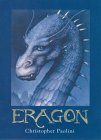***Eragon
Inheritance, Book One
by Christopher Paolini
Reviewed April 20, 2004.
Alfred A. Knopf, New York, 2004. 256 pages.
Available at Sembach Library (J MCN F PAO).
You’ve probably heard about this book. The author began writing
it at fifteen and self-published it. It was picked up by Alfred A.
Knopf when he was nineteen and has now spent weeks on the New York Times
bestseller list.
All my readers know that I love young adult fantasy. But when
this came in, I scanned through it and saw the apostrophes sprinkled through
the names, as if it had come straight out of Diana Wynne Jones’
Tough
Guide to Fantasyland (a guide book to stereotypical fantasy fiction),
and I couldn’t bring myself to read it.
After a few weeks of more hoopla, I decided I really should check it
out. I did find a stereotypical plot,
The Lord of the Rings
combined with
Star Wars. We’ve got an orphan farm boy
of unknown parentage named Eragon living with his uncle. He finds
a magic object loaded with destiny, a dragon egg. They live in a
world of men, elves, dwarves and goblins, which for some reason are called
Urgals. The Uruk-hai are called Kull. We’ve got an evil empire
looking for the object and sending out their Black Riders to find it.
(Only this time they are called Ra’zac.) Of course, the uncle is brutally
murdered by the Black Riders. The innocent farm boy goes seeking revenge.
(I could have told him that was a bad idea. You don’t go looking for
Black Riders!) Of course dragons communicate with their Riders telepathically,
and help their Riders use magic, which Eragon must learn to harness and
control.
That’s not all. There’s a wise old mentor who accompanies Eragon
for awhile on his travels and trains him in the ways of the Force, I mean
magic. They even discover an imprisoned princess to rescue.
There’s a prophecy, in the form of a fortune-teller. She gives away
perhaps a bit too much. I’m now convinced that Eragon’s father is
going to end up being the Darth Vader equivalent, though it’s a little bit
different from Star Wars in that the Obi Wan character killed this Darth
Vader years ago. (I could still be wrong, as Eragon’s father hasn’t
been revealed in this first book, but my suspicions are pretty strong.)
Okay, all of these stereotypical plot elements were revealed in the
first half of the book, and I found them a bit much. After that, when
things started becoming a little more original, I did get more caught up
in the story.
I like the dragon, Saphira. I like the way the author shows the
joy and wonder of riding a dragon. I like Saphira’s character and
her conversations with Eragon. I also like the fortuneteller character
and her werecat.
The writing is not too bad. The second chapter begins as “The
sun rose the next morning with a glorious conflagration of pink and yellow,”
but that was the last place where the writing tripped me up. (That
example made me think of the teacher in L. M. Montgomery’s “Emily of New Moon”
who urges aspiring writer Emily to let the sun rise and set in the ordinary
way.) I have a feeling that Michelle Frey, the editor from Knopf books,
did an excellent job. In a Writer’s Digest article, Christopher Paolini
confessed that they did some drastic cutting after Knopf took the book on.
I am very glad that the book isn’t any longer.
My readers know that I’m not crazy about some of the adult fantasy
books that I’ve tried to read. They seem to get hung up on details
of the imaginary worlds, and often the characters do too much agonizing.
This book didn’t suffer from those flaws. The story moves along at
an interesting pace. Instead of agonizing, when Eragon has questions,
he discusses them with Saphira, and that’s much more interesting than a
character agonizing with his own soul.
After I had written most of this review, I looked at Christopher Paolini’s
website. (You can link to it on my page of
Links for Book Lovers.) He admits that he
was trying for the archetypal hero’s quest. I know that George Lucas
followed the format of the “Hero’s Journey.” However, he used that
format in a way that had never been done before.
Eragon feels
like the plot of
Star Wars in the world of
The Lord of the Rings.
It seemed more like stereotypes than archetypes.
Another interesting thing from Christopher Paolini’s website was that
the fortuneteller—one of my favorite characters in the book—was based on
his sister. So when he created a character based on a real person instead
of the requirements of the Hero’s Journey plot, he was much more successful
at making that character come to life.
Still, I have read worse copies of
The Lord of the Rings.
I think it’s definitely better writing than the last adult fantasy epic
I tried to read but couldn’t finish (and shall remain nameless).
I’m thinking it might be a good next step for fans of the Redwall books.
(I admit I’m not a big fan of those books, but they have the same epic
feel.)
I did like this book, and more so the further I read. I admit
that I’m much more impressed by Christopher Paolini’s marketing abilities
than his writing abilities, but it is a good book, and an amazing accomplishment
for a teenager. When the next book comes out, I will want to read
it. I do want to find out what happens next for Eragon and Saphira.
Reader comment:
Two readers give this book Five Stars.
Copyright © 2004 Sondra Eklund. All
rights reserved.
